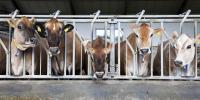The Fit for 55 package neglected emissions from agriculture, so now it is time to step up

It is crucial that the EU's forthcoming climate and food policy is designed in a way that does not simply dismantle European agriculture and relocate production to other countries.
Many battles within Europe have previously been fought on the agricultural soils, and moving forward agriculture will be the next battleground in the EU's climate policy. The dust has just settled after the negotiations of key parts of the major climate package 'Fit for 55'. In the negotiations of the climate package, there were big political battles around issues such as a phase-out date for the sale of new petrol and diesel vehicles and the introduction of an emissions trading system for road transport and buildings. However, the agricultural sector largely escaped new regulations.
While European agriculture has achieved significant productivity improvements, greenhouse gas emissions in the sector have hardly decreased at the EU level in the past 15 years. A recent analysis from the European Environment Agency indicates that agricultural emissions are projected to decrease by only 1.5% from 2020 to 2040 based on current national policies and measures.
The EU potentially needs to reduce total greenhouse gas emissions by around 90% by 2040, and with such a high target no sectors can be exempted. Therefore, we need new and stronger EU-wide measures to reduce agricultural emissions that create a consistent and ambitious playing field on the pathway toward a sustainable food system in the EU.
Lack of climate policy in agriculture
In the area of climate policy, agriculture is primarily subject to differentiated national reduction targets in the EU, which also cover other sectors. This has so far contributed to a diverse and generally insufficient climate regulation of agriculture across the Member States.
In addition to national reduction targets, the European Commission has suggested to reduce agricultural emissions by gradually adopting some of the best available climate technologies in the sector with its proposal for the Industrial Emissions Directive. However, the directive seems to be watered down in the negotiations. For example, less than 3% of the cattle farms in the EU will be covered by the requirements, if the Member States have their way. Therefore, the directive will not provide sufficient incentive to reduce emissions in the sector.
The greenhouse gas emissions from agriculture are also affected by other environmental legislations (such as the Nitrates Directive and the Water Framework Directive) and are subject to requirements in the EU's Common Agricultural Policy. However, more targeted and ambitious regulation is needed to ensure that European agriculture is on the right track.
Introducing emissions trading for agriculture
Agriculture is currently the only sector in the EU not subject to the ‘polluter pays principle’. This has raised concerns from the European Court of Auditors and the OECD. Against this backdrop, the European Commission recently initiated a public consultation on the EU's climate targets and policies post-2030, asking about the possibility of introducing emissions trading for agriculture.
An emissions trading system caps greenhouse gas emissions by issuing a limited number of allowances. The actors covered must surrender one allowance for each ton of CO2e they emit. They can purchase the allowances at auction and trade them freely, thus creating an allowance price.
Emissions trading, similar to the upcoming Danish carbon tax for agriculture, would provide a clear economic incentive – which is currently lacking – to bring about the necessary changes in agricultural production and to develop and implement effective reduction measures. It would also send a strong signal to private actors, that there is business in developing measures for the transition of European agriculture. Furthermore, it would ensure a common playing field and equal competition between farmers within the EU.
In practice, there are several different models for introducing emissions trading in agriculture. Naturally, these models should take into account farmers' opportunities to reduce emissions, administration, and the risk of carbon leakage to countries outside the EU. These elements can and should be dealt with, and emissions trading for agriculture appear to be the right way forward in the EU.
A comprehensive climate and food policy
Emissions trading for agriculture must be integrated with other instruments that will be crucial for the green transformation of the food system. This includes an ambitious green reform of the Common Agricultural Policy, a robust European certification framework for carbon removals focusing on certificates with significant, secure, and long-lasting climate effects (e.g. within carbon farming), and the forthcoming legislative framework for sustainable food systems (SFS), just to mention a few of the most significant initiatives.
It will be essential to consider EU citizens' relatively high consumption of food with a high carbon footprint across these initiatives. It is still unclear what measures the upcoming proposal on the SFS will consist of, but sustainability labelling of food is expected to play a central role.
Shifting Europeans' dietary habits to a more plant-based diet has significant climate potential and would also be beneficial for public health. Therefore, the proposal should be ambitious and facilitate a transition away from food with a high carbon footprint as well.
It is crucial that the EU's forthcoming climate and food policy is designed in a way that does not simply dismantle European agriculture and relocate production to other countries. On the contrary, it should promote a food system that produces a sufficient amount of tasty and nutritious food with a low carbon footprint, while offering good business opportunities and significant improvements for the environment and biodiversity.
Translation of a column brought in Klimamonitor May 31st, 2023.


